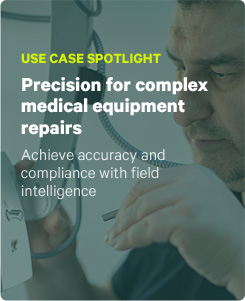Data is the lifeblood of any modern business, and field service is no different. When you use forms automation to capture, organize, and serve data correctly, it gives you a clear advantage over the competition—especially in terms of decision-making.
Because of human error and processing lags, traditional forms prevent your team from making agile decisions. When you’re able to digitize data collection and handling, however, you’ll give your engineers the ability to respond to changing trends and improve the customer experience.
In this article, you’ll learn what forms automation is, what it can do for your business, and what to look for in forms software.
What is forms automation?
Simply put, forms automation takes orders, checklists, field records, and other paper-based business documents and digitizes them through software. With advanced features, you can also make, send, fill out, process, share, and file information.
How does it help businesses?
The major benefits of forms automation are cost savings and increased productivity.
Through automation, you streamline dependent processes by synchronizing information sharing at the point of capture. By eliminating repetitive and tedious tasks, you can focus on what matters and automate form creation, completion, and submission.
These savings accumulate over time, meaning you can cut costs or invest in other areas of your company.
Forms automation in action
Take one of our customers, SUEZ. They completely changed how they do annual inspections with forms automation.
Previously, they did everything on paper—from inspections to documentation. Because of the various gathering techniques, their system could not deliver information quickly and accurately.
Through automation, they can now use their data to better spot flaws. For example, by placing triggers along the path of their end-to-end processes, they can immediately document and flag safety issues for review when an engineer completes a form.
This transformation has dramatically impacted their ability to deliver services. In some areas, their staff is spending more time reviewing and improving than processing, saving up to 80% of their time. From the initial inspection to delivery of the pricing package, they have shortened the entire process from 15 weeks to 5.
“The impact has been pretty great. A lot of time reduced and spending with all the departments in building output documents, putting together the information, having all of the data points right there at their fingertips has been really good.”
BRIAN MORROW, DIRECTOR OF QA & QC – NORTH Region
Where is forms automation used?
Forms automation is suitable for many use cases, including:
- Enterprise Asset Management
- Field Service Management
- Fleet Management
- Incident & Safety Hazards
- Inspection & Audits
- Installation & Maintenance (i.e., HVAC systems)
- Safety Management
What is forms automation software?
Forms automation software is a tool that lets you automate and control workflows by creating digital documents. But how do you choose the right solution? Here are a few questions to ask:
How difficult is it to implement and use?
The complexity of a solution may give it more features but can also make it more challenging to work with. Besides causing lost productivity as you struggle to keep pace with changes in service requirements, this can cause headaches for your engineers as they try to figure things out on the job. Also, your field operations analysts can get frustrated if they have to rely on IT to keep delivering value.
That’s why choosing a forms automation platform that’s easy to deploy and doesn’t restrict engineer productivity is essential.
What’s the mobile experience?
The platform must allow for quick onboarding and iterative process improvements. It should also have an intuitive, easy-to-use mobile app that allows engineers to work offline and seamlessly sync when they reconnect. It must be robust enough for complex fieldwork but have an in-app experience that’s simple enough for even the most technology-resistant fieldworker.
How does it handle field complexity?
Let’s face it. Changing conditions, regulations, and customer requirements all complicate fieldwork. You need engineers focused on creating value, identifying opportunities, and delivering services to your customers, spending more time on paperwork and struggling to clear administrative responsibilities off of their plates.
To raise customer satisfaction and lower risk, you must be able to capture and log complex data on-site. The more versatility a solution has in data and question types, the better your engineers can log what is happening in the field. A no-code platform that can quickly automate complex work processes with features like conditional logic and data routing can help engineers do their best work in a shorter amount of time.
Does the solution integrate with all your systems?
Earlier in this blog, we talked about how information is the lifeblood of every company. The overall performance of a company suffers when the correct data does not circulate properly through it, just as it would if the blood did not circulate appropriately through an organic body.
Platforms should adapt to you, not the other way around. You can save resources and make better decisions by having a platform that can pull and push data across all your core office systems, whether you use Salesforce for customer relations or a field service management platform like ServiceMax or ServiceNow.
Conclusion
Forms automation can be an unquestionably effective tool, especially when you consider the compliance and customer service pressures that field service organizations face today. It not only saves your engineers’ time while they are out in the field, but it also enables your business to make smarter decisions.
Book a demo today to find out how quickly you can drive customer value by deploying ProntoForms’ automated mobile forms that help your field engineers do complex work more quickly and effectively.




